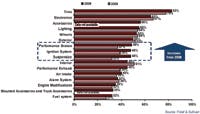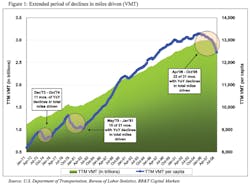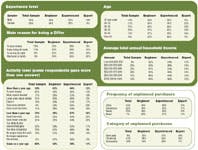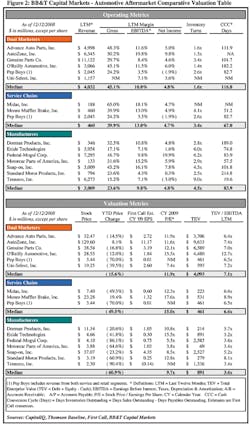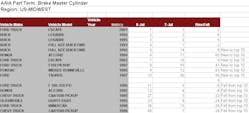Now your tech customers can stop sending drivers to the dealer for updates.
When car manufacturers started using computers to operate engines, software updates became part of a tech's job. At first, updates were accomplished by replacing a memory chip in the control unit or the control unit itself. But by the time on-board diagnostics two (OBDII) was introduced, most powertrain control modules (PCMs) could be reprogrammed.
Emissions-related software updates were available to the aftermarket, as required by the U.S. Environmental Protection Agency (EPA), but they could be installed only with a manufacturer-specific tool. Because the EPA wants the aftermarket to be able to perform all types of emissions-related repairs and they cannot require shops to purchase specific brands of tools, they turned to the Society of Automotive Engineers (SAE) and the tool and equipment industry for an answer. The result was a universal communication protocol defined by SAE Recommended Practice J2534.
The communication protocol, later revised to J2534-1, is a translator that allows a personal computer (PC) to communicate with the PCM on all makes and models. The translation software is contained in a separate piece of hardware that connects to a PC and to the OBDII port. It is not a computer or scan tool, but a pass-through device that enables a PC to interrogate and install software into the PCM's permanent memory.Once this tool became available, the EPA enacted a rule requiring all manufacturers to make their PCM update installation software run on a PC using the Microsoft Windows 2000-or-later operating system. The rule also requires the updates and installation programs to be available through the OEM's information Web sites, either as a downloadable program or on disc, "at a reasonable price."
The rule applies to 2004 and later model-years and only requires access to software that affects emissions. However, some automakers have extended coverage as far back as 1993, and some allow reprogramming of non-emissions related control units.
Getting started
An OEM Web site logon is needed to purchase the installation program and the software update, and the prices vary quite a bit. For instance, Toyota sells a "calibration CD" for $55, and it has the most recent calibration files for all models, all applicable service bulletins and the Update Wizard installation software.The disc can be purchased by part number and is available to registered members of Toyota's Web site. Registration is free. It's certainly a "reasonable price," but the information on that disc is updated as it becomes available. Because all versions of the disc bear the same part number, there's no way to know if a disc purchased last month is still current. It would be safe to purchase a new disc for each job.
General Motors' (GM) aftermarket "reprogramming kit" is available through the Vetronix Web site, makers of GM's Tech II scan tool, as well as from GM's subscription-based service information Web site. The kit lists for more than $1,000, but it includes a CD with all installation software for all control modules on all models back to 1993, plus a one-year Web site subscription to the most current software updates.
Compared with Toyota, it's expensive, but that price buys full access to every update for the current calendar year (not one year from date of purchase). The GM dealers' Web site (www.tis2web.service.gm.com) sells updates a la carte by VIN, and at this writing, the site was being prepared for aftermarket access.Recalibrating
The first step in recalibrating a PCM is to identify the existing calibration. This can be done by interrogating the PCM with a scan tool (Mode 9) and checking a calibration list on the OEM or Equipment and Tool Institute (ETI) Web site.
To reprogram a PCM without a factory scan tool, you need the software, a PC or laptop computer running the Windows 2000-or-later operating system, a high-speed Internet connection and a pass-through tool. Check the OEM's Web site for details about Internet browsers and other computer requirements. It's also a good idea to have all the vehicle's ignition keys.
All pass-through tools perform the same function: they connect to the OBDII port and act as the communication link between the car and the PC. It connects to the PC through an Ethernet, USB, serial port or a wireless connection. There are several pass-through tools on the market, and like aftermarket scan tools, some work better with some vehicles than with others.Though the OEMs do not sell the tools, they do test them to validate which ones work best with their vehicles. The tool makers' Web sites have links to the OEM Web sites that have validated their tools. The most important things to look for when purchasing a pass-through tool are OEM validation and compliance with J2534-1 specifications. The OEM Web site will list validated pass-through tools and describe the computer equipment, Web browser and software needed to download and install the PCM updates.
High-speed Internet service is essential. The programs are large, and downloading them through a dial-up connection could take hours. Of the two wireless Internet connection technologies, Bluetooth and 802.11, the latter is five times faster and less prone to interruption. As we'll see later, this is important when programming a Ford PCM. A USB connection also works well, but an Ethernet connection offers the fastest data transfer speed, reducing the opportunity for outside interference with the job.
It is highly recommended to use a stand-alone PC or laptop for reprogramming instead of one that's also used for other jobs in the shop. Although it's one more piece of equipment to buy, there are advantages. Sometimes the job can take more than an hour, and that's time a PC is not available for other jobs. But most importantly, reprogramming is a delicate operation that easily can be corrupted or stopped by other computer processes, and as we'll see later, that can cause big problems. If an existing computer must be used, some people recommend physically disconnecting it from everything else before connecting it to the pass-through tool.Two software packages are needed: the updated PCM software and the PC application (computer program) that installs the software on the PCM. For most makes, both can be downloaded to the PC before connecting the PC to the pass-through tool.
However, Ford requires a "live" communication link between the vehicle and Ford's own server while the PCM is being updated. This makes it even more compelling to use a stand-alone PC that's not connected to anything else in the shop.
Pardon the interruption
Failed reprogramming can ruin some PCMs, requiring the purchase of a new one. The surest way to cause programming failure is to interrupt the process, and the three most likely sources of interruption are the computer, the vehicle's battery and the tech.To avoid computer interruptions, pop-up blockers, virus protection and firewall software must be turned off. If the PC is connected to a shop's local area network (LAN), this not only puts the entire network at risk, it also increases the possibility of the job being interrupted by something else on the LAN. The job also can be interrupted by other applications such as e-mail, so they should all be closed; screensavers, power savers and all other automatic processes should be disabled.
During reprogramming, battery voltage to the PCM and to pass-through devices take their power from the OBDII connector and must remain constant. For part of the process, the ignition switch must be turned on, which may automatically turn on lights or other loads that cause a significant battery voltage drop. This makes it unsafe to rely on the vehicle's own battery, even if it's fully charged. Connecting a jump pack or a second fully charged battery with jumper cables is a good idea. A better idea is to connect a 12-volt regulated power supply that can produce at least 30 amps of extremely "clean" power. A typical battery charger produces almost enough ripple to interrupt the reprogramming all by itself.
Reprogramming also is interrupted by accidentally turning something on, such as interior lights, the remote door locks, even the security system's motion sensor. Because the job requires turning on the ignition key at some point, the key should remain in the ignition and the driver's window should be open so the tech can reach in to turn the key without opening a door. Make sure the security system is completely turned off. If the vehicle has a proximity device that automatically activates the security system when leaving the vehicle, make sure that card or key fob is inside the vehicle.
One way to avoid interruptions is to remove the PCM from the vehicle and reprogram it on the bench. This requires special cables and connectors, but when properly set up for off-board reprogramming, the chances of success are greater.
Get out, get going
Once all the software is downloaded into the PC and all the safeguards against interruption are in place, it's time to launch the reprogramming application. Again, Ford is different from the others, because the reprogramming application is on the Ford server; the calibration update is sent to the PC, but it disappears once the job is completed.
When reprogramming is completed, the vehicle has a fresh PCM that needs to relearn some of what it knew before. The procedure could be as simple as completing a drive-cycle, but more reprogramming may be necessary. If that includes the security system, all of the vehicle's ignition keys are needed. Relearn procedures are available on the OEM's information Web site.
After an update is successfully installed, it cannot be installed again on that PCM. On most vehicles, the tech can start over if the reprogramming is interrupted.
Hitting the bottom line
J2534-1 has been superceded by J2534-2, and -3 is on the way. Many pass-through tools already meet the -3 specifications and are being validated by the OEMs now. This points out that J2534 is not an SAE standard, but a recommended practice, which SAE says "is intended as a guide toward standard practice and is subject to change to keep pace with experience and technical advances."
In other words, it's a living document, not a standard, and the people who created it understand the future of on-board computers, because they are the same automotive engineers who are creating that future. Reprogramming is already an important part of automotive service, and in their view, it will eventually be a major part of a tech's job.
Be careful, not fearful
PC is not for novices. It requires computer skills, some familiarity with the OEMs' Web sites and with the vehicle, and careful and undivided attention to detail. It also requires an investment in equipment and, for each job, an investment in software.
Once your tech customers make the investment and master the technique, it's good business. The equipment costs can be spread over many invoices, and the software and Web site access charges can be billed as parts.
Most importantly, the ability to reprogram PCMs means they can service more of their customers' needs. Tell them to be careful, not afraid.

